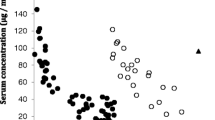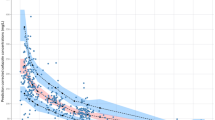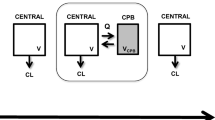Abstract
Purpose
To elucidate whether a dose of 2 g cefoxitin as a prophylactic agent in patients undergoing elective colorectal surgery is able to maintain free drug concentrations above the minimum inhibitory concentration of the microorganisms involved in surgical site infection.
Methods
This was a prospective study involving 56 patients electively undergoing rectal or colon surgery. All plasma concentration–time data were analyzed simultaneously using the population approach to estimate population pharmacokinetic parameters and study the influence of the subjects’ demographic characteristics, disease status, surgical procedure, and clinical laboratory values on the pharmacokinetic properties of cefoxitin.
Results
A one-compartment open model was chosen to describe plasma concentrations of cefoxitin. Since cefoxitin is eliminated almost entirely via the kidney, creatinine clearance was identified as a covariate of cefoxitin clearance. The relationship between total cefoxitin clearance (CL) and creatinine clearance (CLCR) was best described using a nonlinear model [CL = 11.5 × (CLCR/77)0.52]. The population apparent volume of distribution was 12 L. Computer simulations carried out to determine the probability to maintain free plasma concentrations above 8 mg/L (the concentration threshold for susceptible bacteria) 2 h after drug administration revealed that this probability decreased from 84% in patients with a CLCR of 40 mL/min to 28% in patients with a CLCR of 100 mL/min.
Conclusions
To ensure cefoxitin target concentrations during surgery, we recommend that cefoxitin be administered every 1.5 h in patients with a CLCR ≥60 mL/min and every hour if the CLCR is ≥100 mL/min. Administration by continuous infusion preceded by a bolus injection should also be considered.





Similar content being viewed by others
Abbreviations
- CL:
-
Total cefoxitin clearance
- CLCR :
-
Creatinine clearance
- FOCE:
-
First-order conditional estimation
- npde:
-
Normalized prediction distribution errors
- OFV:
-
Objective function value
References
Aoun E, El Hachem S, Abdul-Baki H, Ayyach B, Khalifeh M, Chaar H, Kanafani ZA, Kanj SS, Sharara AI (2005) The use and abuse of antibiotics in elective colorectal surgery: the saga continues. Int J Surg 3(1):69–74
Mangram AJ, Horan TC, Pearson ML, Silver LC, Jarvis WR (1999) Guideline for prevention of surgical site infection, 1999. hospital infection control practices advisory committee. Infect Control Hosp Epidemiol 20(4):250–278
Nichols RL (1995) Surgical antibiotic prophylaxis. Med Clin North Am 79(3):509–522
Brumfitt W, Kosmidis J, Hamilton-Miller JM, Gilchrist JN (1974) Cefoxitin and cephalothin: antimicrobial activity, human pharmacokinetics, and toxicology. Antimicrob Agents Chemother 6(3):290–299
Pinder M, Bellomo R, Lipman J (2002) Pharmacological principles of antibiotic prescription in the critically ill. Anaesth Intensive Care 30(2):134–144
Bratzler DW, Houck PM (2004) Surgical Infection prevention guidelines writers workgroup. antimicrobial prophylaxis for surgery: an advisory statement from the national surgical infection prevention Project. Clin Infect Dis 38(12):1706–1715
Brogden RN, Heel RC, Speight TM, Avery GS (1979) Cefoxitin: a review of its antibacterial activity, pharmacological properties and therapeutic use. Drugs 17(1):1–37
Goodwin CS, Raftery EB, Goldberg AD, Skeggs H, Till AE, Martin CM (1974) Effects of rate of infusion and probenecid on serum levels, renal excretion, and tolerance of intravenous doses of cefoxitin in humans: comparison with cephalothin. Antimicrob Agents Chemother 6(3):338–346
Ko H, Cathcart KS, Griffith DL, Peters GR, Adams WJ (1989) Pharmacokinetics of intravenously administered cefmetazole and cefoxitin and effects of probenecid on cefmetazole elimination. Antimicrob Agents Chemother 33(3):356–361
Kampf D, Schurig R, Korsukewitz I, Bruckner O (1981) Cefoxitin pharmacokinetics: relation to three different renal clearance studies in patients with various degrees of renal insufficiency. Antimicrob Agents Chemother 20(6):741–746
Schrogie JJ, Davies RO, Yeh KC, Rogers D, Holmes GI, Skeggs H, Martin CM (1978) Bioavailability and pharmacokinetics of cefoxitin sodium. J Antimicrob Chemother 4(B):69-78
Sonneville PF, Kartodirdjo RR, Skeggs H, Till AE, Martin CM (1976) Comparative clinical pharmacology of intravenous cefoxitin and cephalothin. Eur J Clin Pharmacol 09(5–6):397–403
Sun H, Fadiran EO, Jones CD, Lesko L, Huang SM, Higgins K, Hu C, Machado S, Maldonado S, Williams R, Hossain M, Ette EI (1999) Population pharmacokinetics. a regulatory perspective. Clin Pharmacokinet 37(1):41–58
Shah VP, Midha KK, Findlay JW et al (2000) Bioanalytical method validation–a revisit with a decade of progress. Pharm Res 17(12):1551–1557
Food and Drug Administration (1998) Guidance for industry: bioanalytical methods validation for human studies. Center for Drug Evaluation and Research, Rockville
Beal SL, Sheiner LB (1992) NONMEM user’s guide. University of California NONMEM Project Group, San Francisco
Boeckmann A, Sheiner L, Beal S (eds) (1992) NONMEN user’s guide, part V. Icon Development Solutions, Ellicott City
Karlsson MO, Jonsson EN, Wiltse CG, Wade JR (1998) Assumption testing in population pharmacokinetic models: illustrated with an analysis of moxonidine data from congestive heart failure patients. J Pharmacokinet Biopharm 26(2):207–246
Karlsson MO, Savic RM (2007) Diagnosing model diagnostics. Clin Pharmacol Ther 82(1):17–20
Savic RM, Karlsson MO (2009) Importance of shrinkage in empirical bayes estimates for diagnostics: problems and solutions. AAPS J 11(3):558–569
Lindbom L, Ribbing J, Jonsson EN (2004) Perl-speaks-NONMEM (PsN)—a Perl module for NONMEM related programming. Comput Methods Programs Biomed 75:85–94
Karlsson MO, Holford NH (2008) A tutorial on visual predictive checks (Abstr 1434). Available at: www.page-meeting.org/?abstract=1434
Kunin CM (1966) Clinical pharmacology of the new penicillins. 1. The importance of serum protein binding in determining antimicrobial activity and concentration in serum. Clin Pharmacol Ther 7(2):166–179
Kunin CM, Craig WA, Kornguth M, Monson R (1973) Influence of binding on the pharmacologic activity of antibiotics. Ann N Y Acad Sci 226:214–224
Gillett AP, Wise R (1978) Penetration of 4 cephalosporins into tissue fluid in man. Lancet 1(8071):962–964
Schrogie JJ, Rogers JD, Yeh KC et al (1979) Pharmacokinetics and comparative pharmacology of cefoxitin and cephalosporins. Rev Infect Dis 1(1):90–97
Carver PL, Nightingale CH, Quintiliani R (1989) Pharmacokinetics and pharmacodynamics of total and unbound cefoxitin and cefotetan in healthy volunteers. Antimicrob Chemother 23(1):99–106
Cannon DC (1974) Kidney function tests. In: Henry RJ, Cannon DC, Winkelman JW (eds) Clinical Chemistry: principles and techniques. Harper and Row, New York
Vlasses PH, Holbrook AM, Schrogie JJ, Rogers JD, Ferguson RK, Abrams WB (1980) Effect of orally administered probenecid on the pharmacokinetics of cefoxitin. Antimicrob Agents Chemother 17(5):847–855
Brendel K, Comets E, Laffont C, Laveille C, Mentre F (2006) Metrics for external model evaluation with an application to the population pharmacokinetics of gliclazide. Pharm Res 23(9):2036–2049
Comets E, Brendel K, Mentre F (2008) Computing normalised prediction distribution errors to evaluate nonlinear mixed-effect models: the npde add-on package for R. Comput Methods Programs Biomed 90:154–166
Pea F, Viale P, Furlanut M (2003) Antimicrobial agents in elective surgery: prophylaxis or "early therapy"? J Chemother 15(1):3–11
Clinical and Laboratory Standards Institute (CLSI) (2010) Performance standards for antimicrobial susceptibility testing. Twentieth informational supplement, M100-S20. CLSI, Wayne
Davis SS, Burnham WR, Wilson P, O’Brien J (1985) Use of adjuvants for enhancement of rectal absorption of cefoxitin in humans. Antimicrob Agents Chemother 28(2):211–215
Reeves DS, Bullock DW, Bywater MJ, Holt HA, White LO, Thornhill DP (1981) The effect of probenecid on the pharmacokinetics and distribution of cefoxitin in healthy volunteers. Br J Clin Pharmacol 11(4):353–359
Ravva P, Gastonguay MR, Tensfeldt TG, Faessel HM (2009) Population pharmacokinetic analysis of varenicline in adult smokers. Br J Clin Pharmacol 68(5):669–681
Nandy P, Samtani M, Lin R (2010) Population pharmacokinetics of doripenem based on data from phase 1 studies with healthy volunteers and phase 2 and 3 studies with critically ill patients. Antimicrob Agents Chemother 54(6):2354–2359
Li C, Kuti JL, Nightingale CH, Nicolau P (2006) Population pharmacokinetic analysis and dosing regimen optimization of meropenem in adult patients. J Clin Pharmacol 46:1171–1178
Scaglione F (2010) Pharmacokinetic/pharmacodynamic (PK/PD) considerations in the management of Gram-positive bacteraemia. Int J Antimicrob Agents 36[Suppl]:S33–S39
MacGowan A (2011) Revisiting beta-lactams—PK/PD improves dosing of old antibiotics. Curr Opin Pharmacol 11(5):470–476
Leggett JE, Fantin B, Ebert S, Totsuka K, Vogelman B, Calame W, Mattie H, Craig WA (1989) Comparative antibiotic dose-effect relationships at several dosing intervals in murine pneumonitis and thigh infection models. J Infect Dis 159(2):281–292
Nelson RL, Glenny AM, Song F (2009) Antimicrobial prophylaxis for colorectal surgery. Cochrane Database Syst Rev; CD001181
Nichols RL (1992) Prophylaxis for surgical infections. In: Gorbach SL, Bartlet JG, Blacklow NR (eds) Infectious diseases. WB Saunders, Philadelphia, pp 393–403
Acknowledgments
This work was supported by Caja Vital Kutxa and by the Departamento de Educación, Universidades e Investigación (IT341-10), Gobierno Vasco, Spain. Silvia Vázquez acknowledges the grant from the Departamento de Sanidad, Gobierno Vasco, Spain.
Author information
Authors and Affiliations
Corresponding author
Rights and permissions
About this article
Cite this article
Isla, A., Trocóniz, I.F., de Tejada, I.L. et al. Population pharmacokinetics of prophylactic cefoxitin in patients undergoing colorectal surgery. Eur J Clin Pharmacol 68, 735–745 (2012). https://doi.org/10.1007/s00228-011-1206-1
Received:
Accepted:
Published:
Issue Date:
DOI: https://doi.org/10.1007/s00228-011-1206-1




